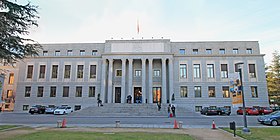
Back Consello Superior d'Investigacions Cientificas AN المجلس الأعلى للبحوث العلمية (إسبانيا) Arabic Conseyu Superior d'Investigaciones Científiques AST Consell Superior d'Investigacions Científiques Catalan Spanish National Research Council CEB Consejo Superior de Investigaciones Científicas German Supera Konsilio por Scienca Esplorado de Hispanio Esperanto Consejo Superior de Investigaciones Científicas Spanish Zientzia Ikerketen Kontseilu Nagusia Basque Conseil supérieur de la recherche scientifique French
 | |
 Headquarters | |
| Agency overview | |
|---|---|
| Formed | November 24, 1939 |
| Preceding agency |
|
| Jurisdiction | Spain |
| Headquarters | Serrano 117. 28006 Madrid |
| Employees | 14,838 (2023)[1] |
| Annual budget | € 1.39 billion, 2022[2] |
| Agency executive |
|
| Parent department | Ministry of Science |
| Website | www |
The Spanish National Research Council[3] (Spanish: Consejo Superior de Investigaciones Científicas, CSIC) is the largest public institution dedicated to research in Spain and the third largest in Europe. Its main objective is to develop and promote research that will help bring about scientific and technological progress, and it is prepared to collaborate with Spanish and foreign entities in order to achieve this aim.
CSIC plays an important role in scientific and technological policy, since it encompasses an area that takes in everything from basic research to the transfer of knowledge to the productive sector. Its research is driven by its centres and institutes, which are spread across all the autonomous regions. CSIC has 6% of all the staff dedicated to research and development in Spain, and they generate approximately 20% of all scientific production in the country.[4] It also manages a range of important facilities; the most complete and extensive network of specialist libraries, and also has joint research units.
Significant latest research by CSIC is the Temperature and Winds for InSight (TWINS) module, which is a component of NASA's InSight Mars lander, which landed successfully on November 26, 2018. TWINS will monitor weather at the Mars landing site.
- ^ "Personal al servicio del Sector Público Estatal". www.igae.pap.hacienda.gob.es. 2023. Retrieved 16 June 2024.
- ^ "2022 CSIC memory".
- ^ Although this is the name officially used as translation in the website of the institution, the actual word-by-word translation would be High Council of Scientific Research
- ^ "Comparecencia del Director General del CSIC, ante el Congreso de los Diputados, para informar sobre el funcionamiento y los resultados del CSIC y su aportación a la investigación" (PDF). Congreso de los Diputados (in Spanish). 24 March 2009. p. 4. Retrieved 11 August 2017.